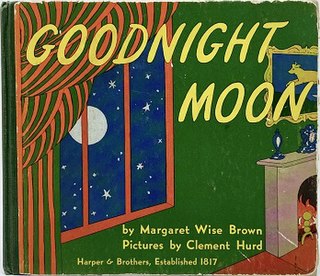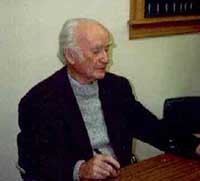
Goodnight Moon is an American children's book written by Margaret Wise Brown and illustrated by Clement Hurd. It was published on September 3, 1947, and is a highly acclaimed bedtime story.

HarperCollins Publishers LLC is a British-American publishing company that is considered to be one of the "Big Five" English-language publishers, along with Penguin Random House, Hachette, Macmillan, and Simon & Schuster. HarperCollins is headquartered in New York City and London and is a subsidiary of News Corp.

Margaret Wise Brown was an American writer of children's books, including Goodnight Moon (1947) and The Runaway Bunny (1942), both illustrated by Clement Hurd. She has been called "the laureate of the nursery" for her achievements.

Little Golden Books is an American series of children's books, published since 1942. The Poky Little Puppy, the eighth release in the series, is the top-selling children's book of all time in the United States. Many other Little Golden Books have become bestsellers, including Tootle, Scuffy the Tugboat, The Little Red Hen, and Doctor Dan the Bandage Man.

Garth Montgomery Williams was an American artist who came to prominence in the American postwar era as an illustrator of children's books. Many of the books he illustrated have become classics of American children's literature.
In Stuart Little, Charlotte's Web, and in the Little House series of books of Laura Ingalls Wilder, Williams['s] drawings have become inseparable from how we think of those stories. In that respect ... Williams['s] work belongs in the same class as Sir John Tenniel's drawings for Alice in Wonderland, or Ernest Shepard's illustrations for Winnie the Pooh.

Clement Gazzam Hurd was an American artist. He is known for illustrations of children's picture books, especially collaborations with writer Margaret Wise Brown, including Goodnight Moon (1947) and The Runaway Bunny (1942).
John Thacher Hurd is an American artist and the creator of children's picture books including Mama Don't Allow and Art Dog.
Charlotte Zolotow was an American writer, poet, editor, and publisher of many books for children. She wrote about 70 picture book texts.

Lillian Hoban was an American illustrator and children's writer best known for picture books created with her husband Russell Hoban. According to OCLC, she has published 326 works in 1,401 publications in 11 languages.
Beth Kephart is an American author of non-fiction, poetry and young adult fiction for adults and teens. Kephart has written and published over ten books and has received several grants and awards for her writing. She was a National Book Award Finalist for her book "A Slant of the Sun: One Child’s Courage."
Ursula Nordstrom was publisher and editor-in-chief of juvenile books at Harper & Row from 1940 to 1973. She is credited with presiding over a transformation in children's literature in which morality tales written for adult approval gave way to works that instead appealed to children's imaginations and emotions.
John Steptoe was an author and illustrator for children’s books dealing with aspects of the African-American experience. He is best known for Mufaro's Beautiful Daughters, which was acknowledged by literary critics as a breakthrough in African history and culture.

Little Fur Family is a 1946 picture book written by Margaret Wise Brown and illustrated by Garth Williams. It tells the story of a little fur child's day in the woods. The day ends when his big fur parents tuck him in bed "all soft and warm," and sing him to sleep with a bedtime song.
The Runaway Bunny is a concerto for violin, reader and orchestra by the contemporary American composer Glen Roven, with text from the classic children's bedtime story The Runaway Bunny by Margaret Wise Brown. The concerto premiered at Carnegie Hall on April 29, 2008 with Roven conducting the American Symphony Orchestra with Glenn Close narrating.
Edith Thacher Hurd was an American writer of children's books. She published 70 books in her lifetime, fifty of them illustrated by her husband, Clement Hurd.
Leonard S. Marcus is an American author and expert on English language children's literature. Marcus has been a critic for several publications including Horn Book and the New York Times Book review. Born and raised in Mount Vernon, New York, he attended Yale University and was editor of the Yale Literary Magazine.

My World: A Companion To Goodnight Moon is an American children's picture book written by Margaret Wise Brown and illustrated by Clement Hurd. The third book in Brown and Hurd's "classic series", it is the "companion" to Brown & Hurd's Goodnight Moon. My World was published in December 1949.
W. R. Scott was a children's literature publisher based in New York City that specialized in visually striking books with a contemporary educational philosophy. W. R. Scott's first editor was Margaret Wise Brown; the company also published a number of her books.
Gene (Eugene) Zion was an American author of picture books.
Susan Hirschman was the founder of children's publisher Greenwillow Books.









